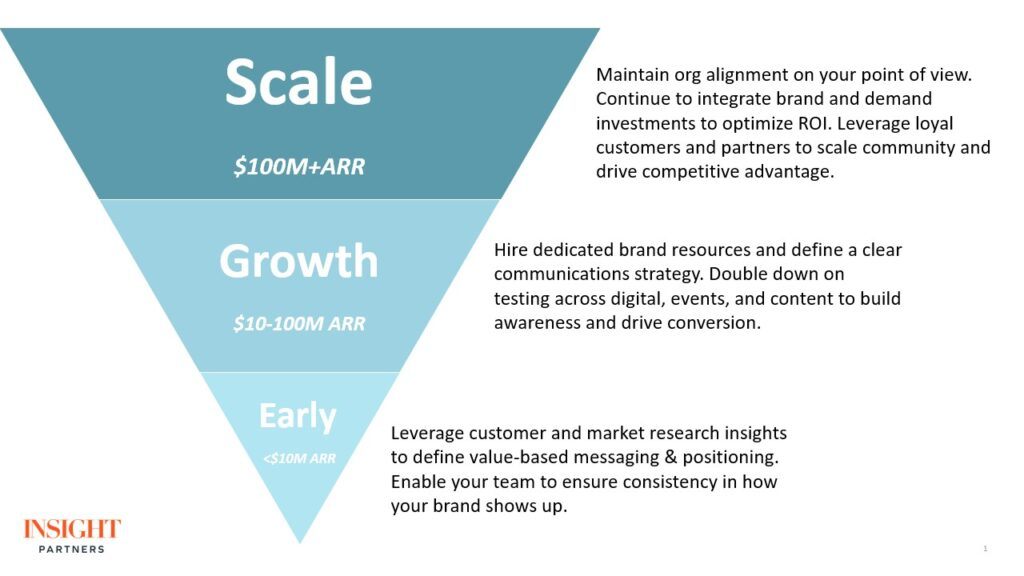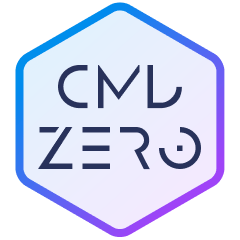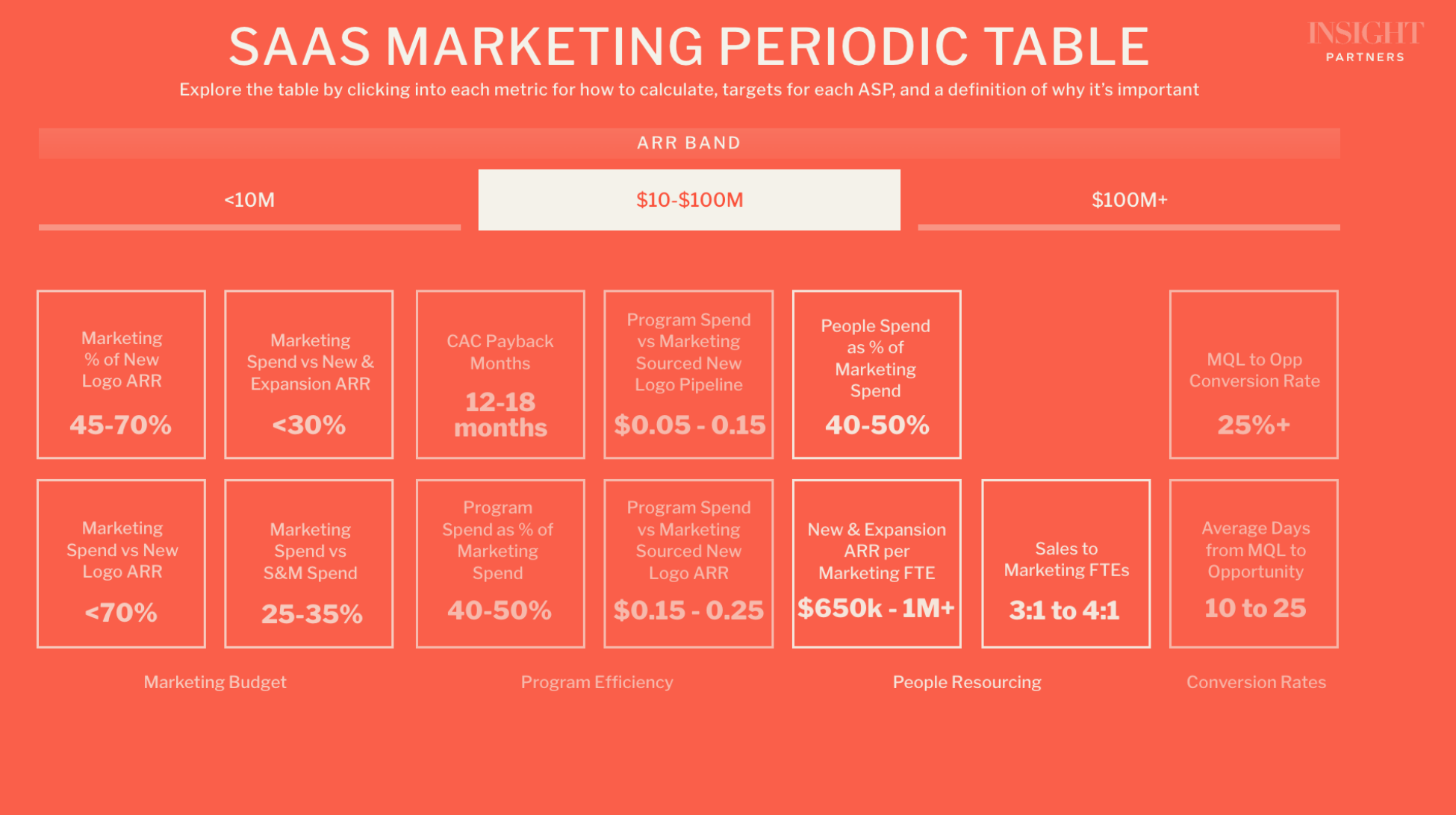Founder 101: How to build your brand at every stage of growth

Investing in brand does not have to break the bank. There are plenty of brand strategies and tactics that cost nothing and drive exponential value. Brand investment is critical for companies looking to build sustainable growth and profitability, as discussed in Founder 101: Why and when to invest in brand. Investing in brand early can save you from future headaches along the scaling journey.
This post walks founders, CEOs, and marketing leaders through the steps needed to set companies up for brand success.
How do I invest in brand at each stage of growth?
Building a brand is a journey. Every stage of growth has different needs.

Early < $10M ARR
While your priorities may be constantly changing at this point in your growth journey, your investment in brand should focus on the essential: leverage buyer insights to understand your ideal customer and develop a company story that articulates how you solve buyer pain points in a differentiated way.
- Harvest insights: Talk to your customers. The insights you derive from running interviews with a diverse set of customers and prospects to understand their pain points will inform your positioning and ensure your messaging resonates with buyers.
- Create the building blocks: Leverage insights from step one to define your strategic brand building blocks.
Ideal Customer Profile (ICP)
Buyer Personas
Mission, Vision & Values (MVV)
Point of View (POV)
Messaging & Positioning (M&P) - Activate in market: Integrate your messaging across your website, sales enablement, and a content/SEO strategy. Test various digital marketing tactics such as paid & organic search and social media to ensure your brand message is authentic to your company values, compelling to your buyers, and differentiated in the market.
Tips for early stage
- Embrace evolving insights: Remember, understanding your buyers, competitors, and market is an ongoing process. Develop a Voice of the Customer (VoC) Program early to keep up with the constant evolution (read more here and here).
- Invest wisely: Avoid hiring an agency too soon. Ensure you’re ready to invest in brand by answering the three brand readiness questions in Founder 101: Why and when to invest in brand. If necessary, hire an agency that specializes in messaging and positioning, but be extra critical of large, expensive brand agencies as your messaging will continue to evolve.
- Be cautious with category creation: Creating a new category is a resource-intensive process, and embarking on that journey prematurely can be a distraction. Focus on articulating your differentiation and the white space you own within your category. Be aware of both risks and rewards of leveling up your analyst relations (AR) strategy; most category creators have significant budgets, and the process can take years.
- Live your brand values: Don’t just define your Mission, Vision, Values; embody them.
- Celebrate milestones where your mission comes to life.
- Amplify your vision by embedding it into strategic plans.
- Broadcast instances where employees live your company values.
Growth $10-75M ARR
As your company scales, maintain a testing mentality and drive hyper-focused campaigns that resonate with your ideal customers. Focus on solidifying a strong brand reputation and loyal customer base.
- Establish brand foundations: Build a brand book to document brand guidelines and use software like Templafy to ensure consistency as your organization grows. Invest in hiring dedicated resources to own your brand’s success, including brand strategy, strategic communications, thought leadership, and creative/design.
- Finetune your brand strategy: Strengthen your product marketing function, as it is a huge driver of brand success. Define your category strategy by understanding the analysts who cover your space and developing a plan to engage analysts proactively.
- Engage your audience and drive demand: Be innovative with your events strategy, setting clear demand and brand goals that make your presence known (think beyond the booth!). Invest in public relations (PR) to create an influential presence for your brand in the market. Double down on your software review strategy via sites such as G2 and Capterra to generate trust and social proof, and reap the SEO benefits as these sites rank highly on organic search.
Tips for growth stage
- Drive an integrated approach: Ensure all your marketing initiatives are part of a larger, cohesive campaign aligned to your buyer’s journey. This amplifies the impact of each tactic and enhances the overall brand activation.
- Think smarter: Deeply understand your target audience, their sources for trusted information, the influencers they follow, and the events they attend. Position yourself strategically to sharpen your targeting efforts and maximize ROI.
- Optimize content production: Scale your content intentionally and drive a multiplier effect where each piece of content can be repurposed in multiple ways, enhancing its reach across campaigns. Leverage GenAI to supercharge your content production.
- Leverage your best customers: Invest in customer advocacy programs and community-led marketing to amplify your brand voice and build trust. Organize a customer/user conference when the time is right to augment customer advocacy.
Scale >$75M ARR
At this crucial inflection point in your growth, you may be starting to reap the “snowball effect” benefits of your brand-building efforts. As the owner of your brand and your company’s business health, strive to balance a focus on demand gen and brand to optimize ROI.
- Devote resources to insights: Allocate full-time roles to customer and market intelligence to keep a pulse on all things customer, competitor, and market so your brand can evolve with, not against, the market.
- Foster strategic partnerships: Partnerships can amplify your brand voice. Co-marketing benefits include reaching a wider audience, boosting social engagement, and strengthening and diversifying your reputation in the market.
- Plan for mergers and acquisitions (M&A): Assign a dedicated team to ensure the research and preparation are completed before public announcements. Get ahead of the many questions you will need to answer, from “will you become a ‘branded house’ or a ‘house of brands’?” to “how will you mobilize the internal teams leading up to the external announcements?”
- Start exit prep early: Have a plan in place at least six months before an Initial Public Offering (IPO) or sale. Marketing plays a key role in preparing your S1 for an IPO and ensuring everything is ready for a sale. Your brand’s market presence directly impacts company valuation.
Tips for scaling companies
- Keep experimenting: Always test and iterate your brand-building strategies to evolve with the market and stay ahead of the competition.
- Align brand to revenue: As budgets increase, it’s crucial to measure brand-focused campaigns’ impact quantitatively. Learn more on brand measurement in Founder 101: How to build a brand scorecard.
- Invest in brand studies and software: Brand awareness studies should be performed when there is a shift in strategy or focus. Hire a research firm to perform the study, clearly outlining your learning objectives and expectations on actioning any learnings. Maintain always-on insights to guide investments through investment in brand intelligence software, like BlueOcean.
Building a brand is a marathon, not a sprint. Your brand will evolve as you grow, and approaching brand building with a right-sized strategy will optimize ROI and ensure you don’t go too big too soon. Continued investment in your brand and aligning to a targeted and data-backed demand strategy is the key to unlocking growth.
Remember, there is no demand without brand.
Explore the SaaS Growth Acceleration Framework
Explore this topic and 40+ other critical business considerations in our interactive SaaS Growth Acceleration Framework for founders and GTM leaders.
Here’s how SaaS leaders ($10m + ARR) can use this framework to win:
- Understand the downstream implications of 40+ critical business decisions
- View how product-related decisions can shake the foundation of your go-to-market strategy
- Dig deeper into any GTM component to view key questions you should be asking when making changes
Editor’s note: Templafy and BlueOcean are Insight Partners portfolio companies.








